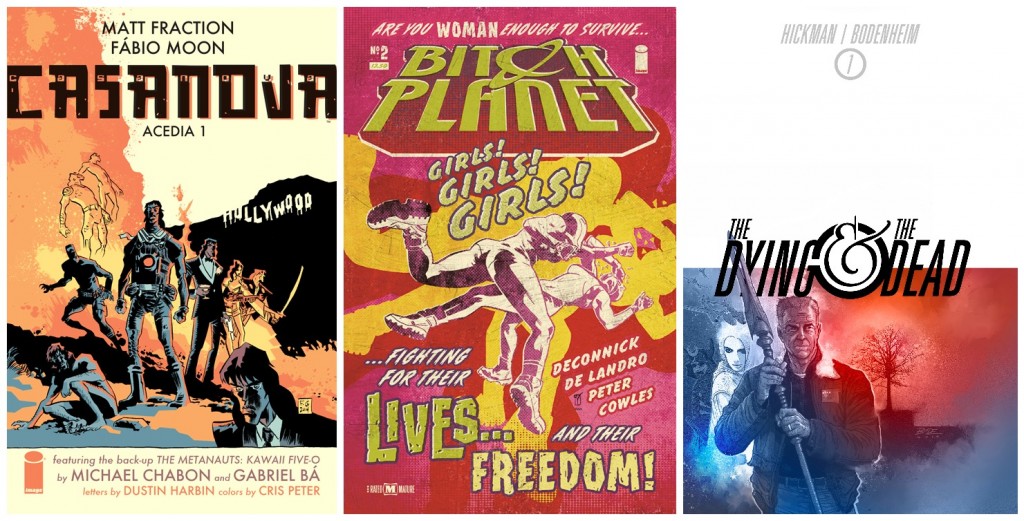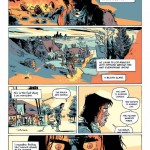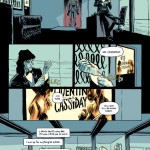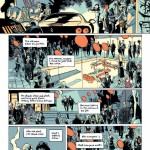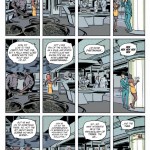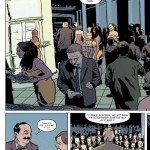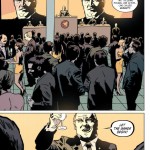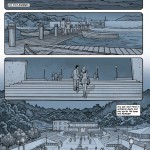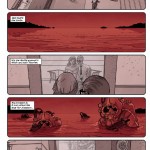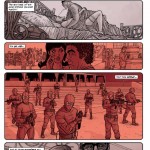It’s Wednesday and that means new comics. Let Deadshirt steer your wallet in the right direction with reviews (and preview pages) of titles out today from Image, Dark Horse, IDW, Boom! Studios, Archie, MonkeyBrain, Oni, Fantagraphics, Top Shelf, Action Lab, and more!
Casanova: Acedia #1
Written by Matt Fraction (back-up by Michael Chabon)
Art by Fabio Moon (back-up by Gabriel Ba)
Colored by Cris Peter
Lettered by Dustin K. Harbin
Image
$3.99
For such a complex book with such a strange publication history (from Image’s old slimline format, to colored reprints at Marvel’s Icon imprint with a new volume, back to Image with more reprints and another new volume), the central conceit of protagonist Casanova Quinn crash landing onto our Earth in the center of Hollywood is a brilliant concept. It makes this the easiest issue of Casanova to pick up since the very first if you’re a new reader, and if this fourth volume has been on your hotly anticipated list since the end of Avaritia, this new status quo has special resonance. Moreso than any of his other work (save maybe Sex Crims), Casanova represents a peek into Matt Fraction’s heart and soul that uses the grand tapestry of Superspies On Infinite Earths to transmogrify deeply personal emotional exploration into apocalyptic pop metacommentary.
What began as a simple story—bad, bad Casanova Quinn being plucked from his own world and placed undercover as his own evil twin in a sister universe—has evolved and rebranded so many times that it’s hard to pin down exactly what the book is all about. Imagine watching the sequel to Richard Linklater’s Before Sunrise and suddenly Ethan Hawke is hired to kill Julie Delpy, and then in the next film they’re both astronauts. It’s Francois Truffaut’s Antoine Doinel series by way of Grant Morrison.
Acedia promises an enticing new turn of the knife, as amnesiac Casanova Quinn is settling into his newfound life as Quentin Cassiday, the useful assistant to an old Hollywood power player who’ll be immediately recognizable to long time readers. Co-creator Gabriel Ba and his twin brother Fabio Moon alternate art each volume of Casanova, and Moon is perfect for this volume, as his lines really captures Quinn at his most vulnerable and mysterious. Harbin’s lettering, too, does a great job of switching between an omniscient narrator and Quinn’s own thoughts. It suggests a multi-layered voiceover in a really engrossing way.
What’s great about the main narrative here is the way it casually throws new pins in the air to juggle for the rest of the arc, like the notion that the world will end in nine days, or the forebodingly arcane sigils that pop up through the first issue. Despite the usually prismatic use of metatextual references (here, best exemplified by a particular Christopher Logue quote) and other comforting elements of the overall “Casanova style”, this issue leaves you feeling as uncertain and shaken as Casanova is. Thankfully a fight scene late in the book brings out some of that undeniably Casanova Quinn dialogue that always reads like a more idiosyncratic Archer.
Michael Chabon and Gabriel Ba doing back up stories here had the potential to be jarring and unnecessary, given the consistently personal nature of the book’s storytelling, but the Kavalier & Clay writer displays similar sensibilities and spins a fun yarn that’s sure to dovetail with the main text sooner rather than later. Honestly, “extra story content from a Pulitzer Prize-winning novelist” should be the fine print on more creator-owned comics content, especially if it helps to push an already incredible title further out of its comfort zone and onto new heights.
– Dominic Griffin
(Click thumbnails to enlarge)
Bitch Planet #2
Written by Kelly Sue DeConnick
Art by Valentine De Landro
Colored by Cris Peter
Lettered by Clayton Cowles
Image
$3.50
Bitch Planet is getting ready to rumble, and I am punch-dancing with excitement over this comic. Kamau Kogo garnered quite a bit of attention for herself when she attempted to stop a murder (and was subsequently blamed for it), and now the powers-that-be want her to fight for the entertainment of millions. These games, referred to as Megaton or Duemila (2,000, as in pounds) depending on where you are from, sound like a mixture of the first Olympics (you know, the naked Olympics), The Hunger Games, and Death Race, and Kamau has to assemble a roster of Bitch Planet’s finest to throw their weight in the ring.
This second issue digs deeper into the class and gender disparities that exist in the world of Bitch Planet (cough-our world-cough). We open with one of the “Fathers” giving an us-versus-them speech and spinning the violence of Duemila/Megaton as good, necessary even, for civilized society. We then see Kamau in solitary, being berated by a computerized mother-figure who blatantly accuses her of murdering a white woman because she was jealous of her skin. What I love most about this comic is that it does not pull punches. Bitch Planet is not here to please every single person that will pick it up. It hasn’t felt the need to balance a female protagonist in an oppressed society with a nice, understanding male lead, and likewise to counter a black protagonist with a friendly white ally. This is raw storytelling, and it’s so unbelievably refreshing.
The cherry on top of this high-octane commentary is Valentine De Landro’s pulp-inspired propaganda cover, which bleeds into the comic through giant, Orwellian TV screens on Bitch Planet. An image of a thin woman demonstrating aerobics in pink pixels looms over the gym as Kamau plots with her fellow inmates, all of whom have different body types and look nothing like this ideal pink image. In the background, Penny Rolle picks a fight with a guard, an all-out brawl takes place, and still the pink woman smiles on. The writing and artwork are woven together so deftly that the message shines through in even the most subtle imagery.
Accompanying essays and fan contributions make me feel like I’m experiencing something significant as a reader. Kelly Sue DeConnick lays out a plan for the run in the back, as well as clarifying that this project is not a monolith of feminism. Readers, even the non-compliant ones, may disagree with what’s presented, but it’s out there now and accessible to anyone. I look forward to watching the reaction to and evolution of this concept that is Bitch Planet.
– Sarah Register
(Click thumbnails to enlarge)
The Dying & The Dead #1
Written by Jonathan Hickman
Art by Ryan Bodenheim
Colored by Michael Garland
Lettered by Russ Wooten
Image
$3.99
I was intrigued by the solicitation for this comic as “Indiana Jones for Old People,” and while the comic seems to be building towards that, it sure takes a long time to get there. In 1969, an artifact is stolen by a mysterious group that may have Nazi ties. Elsewhere, an old man watches helplessly while his wife dies slowly from cancer. He is offered a choice: to help a race of people older than man find the object and save his wife, or continue to watch her die. At the end of the issue, he makes his choice.
That’s a lot of set-up for what sounds like a simple plot, but somehow this book spends over sixty pages on it and it still doesn’t seem overly long. If there’s one thing you can say about Jonathan Hickman, good or bad, is that he sure does love his world-building, and that’s what this comic is. Sure there’s an action scene of a massacre/heist at the beginning, but the rest is almost entirely two characters in a room discussing the nature of the world. There’s a lot of fascinating stuff in this comic; Hickman creates a subterranean race who secretly rule the world and treat humanity as an experiment that has gotten out of hand. However, they now have need of someone to do their dirty work for them: Col. Canning, who has a history with these people. He agrees to help them in exchange for saving his wife, and things jump off from there.
Thanks in large part to Ryan Bodenheim’s excellent art, Hickman manages to tell us a lot of information without seeming like he’s just dropping massive amounts of text on us. Bodenheim’s work is really reminiscent of that of Geoff Darrow, giving us vistas of super-detailed underground cities, but he also draws The City’s inhabitants (the underground people who are not given a proper name in the book) in a slightly different style that makes them seem apart from the rest of the comic, which helps drive home their otherness.
This is a really fascinating book in which nothing really happens, but I loved it. I’m not a huge fan of Hickman’s Marvel work, but I think a lot of that is because he just works better creating his own worlds, rather than trying to paste his own together from others’ work.
– Jason Urbanciz
(Click thumbnails to enlarge)
Be sure to let us know what you picked up this week in the comments below, on Twitter or on our Facebook Page!

